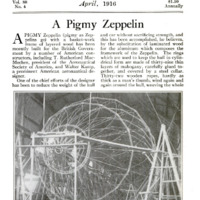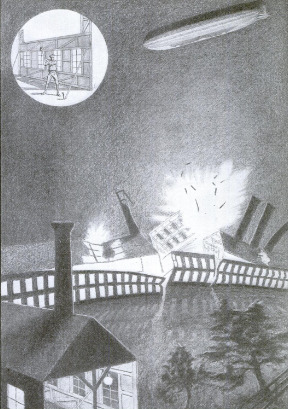Decoy Targets for Zeppelins
Item
-
Title (Dublin Core)
-
Decoy Targets for Zeppelins
-
Article Title and/or Image Caption (Dublin Core)
-
Decoy Targets for Zeppelins
-
Caption: In order to deceive bomb-dropping Zeppelins, the English are building "stage" factories (mere painted scenes) which are illuminated at night
-
extracted text (Extract Text)
-
THERE is no doubt that more
powerful guns are now available
than those which made so ridicu-
lous a showing during the September and
October raids on London, but the
problem of adequate range finding is so
nearly prohibitive that few who are
familiar with it pin much hope to a gun
defense.
1 am credibly informed, however, that
what might be called “diversionary”
protective measures have been employed
with considerable success. These con-
sist of various ingenious devices cal-
culated to draw the fire of the Zeppelins
away from the points where they could
do the most harm. So far, these appear
to have been employed principally in the
important manufacturing districts be-
tween London and the North Sea rather
than in the immediate environs of the
metropolis. The idea ‘is said to have
originated in the mind of a Norfolk
farmer after a pile of chaff which he had
been burning on the night of a raid was
made the target of several well-placed
Zeppelin bombs.
“The Zepps thought my fire was the
blast of the —— mills,” he told an air
service officer. “Why not have some
ready to fool 'em the next time they
come?”
Since factories and barracks were the
main objects of attack, why not provide
some that could be found without diffi-
culty and the destruction of which would
be of small moment. The first experi-
ment was made by cutting “window-
holes” in a row of bill-boards—*‘hoard-
ings” the English call them—along a
railway, and illuminating each orifice
with a carbide lamp. When these came
in for attention from the raiders, the
present plan of using “stage scenery’
factories and barracks as Zeppelin decoys
was outlined.
These decoys consist simply of sec-
tions of imitation walls, pierced with
windows, which, by means of guys and
props, can be made to represent the side
or sky-lighted roofs of a factory or
barracks. Where practicable the illumi-
.
nation is furnished by running a cable
from the nearest electric transmission
line, and where this is too troublesome or
expensive, carbide or kerosene lamps are
employed. The sections hook or clamp
together and are made small enough to
allow of a stack of them being carried on
one of the big war motor trucks.
An interesting light is thrown on this
phase of protective work by a photo-
graph that was published in England
about three months ago, and probably
also in the United States. It showed a
huge war motor truck, with an enor-
mous tarpaulin-covered load, stalled
between the copings of an old stone
bridge over which it had endeavored to
pass. The caption merely explained
that it was “Somewhere in England,”
and that the load itself was an “official
secret.” Most of the information which
I have set down above came to me as a
consequence of this photograph.
I chanced to be looking over the copy
of the Daily Mirror on the cover of
which the view in question appeared,
when a garrulous and slightly inebriated
“Tommy” who shared my third class
apartment with me asked if I knew what
the load was.
“Not beyond the fact that it is an
‘official secret,” I replied. “Do you
know anything about it?"
“‘Blime me if I don’t,” was the answer.
“She wuz carryin’ stage scen'ry; stage
scen’ry fer the Zepps.”
The man, it appeared, was a member
of the Army Service Corps, and was just
returning from the hospital where to use
his own words, he had been to ‘git a
hunk o’ ‘fact’ry’” picked out of him.
His injuries, he said, had been received
when a “factory” which he had helped
to erect was actually struck and de-
molished by a Zeppelin bomb. They
had just switched the lights on from
their dug-out, he said, when the Zeppelin
hove in sight and headed up to pass
right over the decoy. The “factory” was
blown to pieces, but a couple of hours’ re-
pair work on the morrow left theshattered
sections in as good shape as ever.
-
Contributor (Dublin Core)
-
R. J. Bjierstedt (writer)
-
Language (Dublin Core)
-
eng
-
Date Issued (Dublin Core)
-
1916-04
-
pages (Bibliographic Ontology)
-
512-513
-
Rights (Dublin Core)
-
Public Domain (Google digitized)
-
Archived by (Dublin Core)
-
Filippo Valle
-
Alberto Bordignon (Supervisor)
-
Spatial Coverage (Dublin Core)
-
England
 Popular Science Monthly, v. 88, n. 4, 1916
Popular Science Monthly, v. 88, n. 4, 1916



